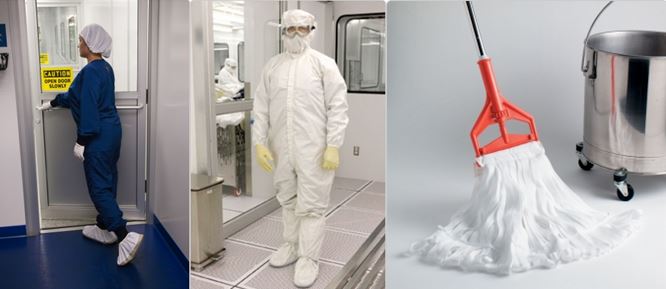How to Combat Dust in the Workplace

Wherever there is air, there is dust, often too small for detection by the human eye. At home, “dust bunnies” can be made up of the usual mix of dust mites, human, and animal skin cells, textile and paper fibers, minerals, or even burnt meteorite particles.(1) Dust is defined as solid particles that may become airborne, ranging from less than 1 µm (a micrometer, or one millionth of a meter), up to 100 µm in size.
In the work environment, dust contamination takes on greater significance, especially when cleanrooms and clean room supplies are required. Airborne dust poses special dangers when inhaled, placing workers at risk of developing occupational diseases or disabilities.
The Dangers of Dust in a Work Environment
Employers and manufacturers must take into account the risks of reduced product quality or serious contamination when workplace dust is not controlled. The World Health Organization (WHO) warns that airborne dust can lead to fire and explosions, in addition to damaging the environment, possibly triggering sanctions, fines, and a damaged reputation.(2)
The degree of danger from dust depends on the materials being handled. Hazardous dust emissions can result from extraction and processing of minerals (including highly dangerous silica), metallic dusts like lead, bulk chemicals, molds and spores, pesticides, and others. Asbestos is an especially dangerous and common mineral dust that is often found on construction sites for demolition or renovation projects.
Airborne dust contamination at work is linked to such grave health consequences as lead poisoning, or lung diseases such as pneumoconiosis, cancer, asthma, allergic alveolitis, and many non-respiratory diseases.
Who Sets the Safety Standards?
Indoor air quality (IAQ) standards are not set in the U.S. by the Occupational Safety and Health Administration (OSHA).(3) However, it does set standards for ventilation and for certain relevant contaminants. States often consult with OSHA when setting their own policies, but only California and New Jersey have Indoor Air regulations, while another 22 states offer OSHA-approved State plans for job safety and health programs.
Cleanroom standards are set by ISO, a global federation of national standards bodies from about 100 countries. ISO classifies cleanrooms by the number and size of particles allowed per volume of air. Ordinary room air would be designated at about Class 9.
Additional information on voluntary, consensus indoor air standards is developed by IESO, the Indoor Environmental Standards Organization, started in 2002.(3) IESO is a subsidiary of the Indoor Air Quality Association.
How to Manage Dust in the Work Environment
The WHO recommends thorough assessment of a dusty workplace to evaluate risk for exposure. They take into account kinds of dust, and sources, along with any controls already in place. Importantly, sampling for exposure should literally be attached to individual workers, often by means of a personal sampler worn by the individual. Solutions can then be developed to rectify and control exposures, such as wet methods or exhaust ventilation.
Keeping the Cleanroom Clean
Managing the rigorous standards of a cleanroom environment demands the highest level of technical expertise and organizational commitment. The concentration of particles in the air are limited to set standards, and other environmental factors in the room must be strictly controlled, including air flow patterns, temperature, humidity, air pressure, and hazardous aerosols.
A complex process, with significant consequences for employees and the entire enterprise, cleanroom management should be undertaken with the aid of specialized experts, like Prudential Cleanroom Services (PCS), an established provider of cleanroom apparel and garment processing since 1960.
Manufacturers that operate in aseptic, particulate & ESD-controlled environments, handling semi-conductor, aerospace, bio-science, medical device, pharmaceutical, and other manufacturing processes, require specialized support from certified vendors like PCS.
A major factor in maintaining cleanroom air standards is the strict use of cleanroom uniforms, and ensuring proper methods for its laundering, packaging, and delivery. Apparel designed for cleanroom workers must take into account types of fabric that meet industry standards and match industry styles. PCS offers approved Class 3 cleanroom garment processing facilities to thoroughly maintain cleanroom standards.
Garment laundering methods follow documented procedures, like the use of pass-through washing machines with deionized water. Washers and dryers move garments into ISO class-rated environments after each step in the cleaning process.
Inspectors flag needed repairs, which are done in an ISO Class 8 controlled environment, using light tables to help identify problems. Garment tracking systems add efficiency and further reduce the need for handling and potential for contamination.
Behavioral Factors
Cleanroom environments are specifically affected by employee behavior. People are a major source of contamination. Before entering the cleanroom, employees will follow a set protocol, leaving all personal items in a “gowning” room, where they change into required cleanroom apparel.(4)
A last step in the laundering process can be crucial in assuring sanitized garments. Folding and packaging services entail each garment being sealed for testing in a test chamber, also known as a “body box.” The box environment allows for testing of movements to measure the garment system’s particle containment levels.
In fact, part of the evaluation of air quality involves measuring the number of airborne particles produced in a room by different types of activities, from sitting, to walking, to a category known as “horseplay” — a more active level of movement.